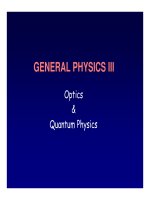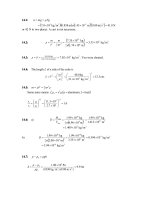Planck, atomic physics, einstein AB coeffecients
Bạn đang xem bản rút gọn của tài liệu. Xem và tải ngay bản đầy đủ của tài liệu tại đây (264.41 KB, 55 trang )
ECE 275B © P.J. Burke, Winter 2003
Last modified 1/2/2003 1:58 AM
Lecture 4, Slide # 1
Lecture 4: Photons and atoms
• Electromagnetic modes in a box
• Blackbody radiation; photons, Planck law
• Photoelectric effect
• Energy spectrum of hydrogen
• Einstein A/B coefficients
•Three-level laser
• Reading: Ch. 7 of Verdeyen
ECE 275C © P.J. Burke, Winter 2003
Last modified 1/2/2003 1:58 AM
Lecture 4, Slide # 2
Boundary conditions:
L
L
L
∧
z
∧
y
∧
x
0=⋅∇
→→
E
If we implement we find two things:
ti
zyxz
ezkykxkEtzyxE
ω
)cos()sin()sin(),,,(
3
⋅⋅=
ti
zyxx
ezkykxkEtzyxE
ω
)sin()sin()cos(),,,(
1
⋅⋅=
ti
zyxy
ezkykxkEtzyxE
ω
)sin()cos()sin(),,,(
2
⋅⋅=
First:
Second:
0
321
=++
zyx
kEkEkE
()
222
2
222
2
zyxzyx
nnn
L
kkk
c
++
=++=
πω
n
1
,n
2
,n
3
integers; at least two must be non-zero.
Each combination of n
1
,n
2
,n
3
is a “mode”.
Discuss superposition.
The magnitude of E
1
, E
2
, E
3
still can be any value!
(Subject to constraints above.)
ECE 275C © P.J. Burke, Winter 2003
Last modified 1/2/2003 1:58 AM
Lecture 4, Slide # 3
How much energy is in the box?
+
=
→→→→→
2
0
2
0
),(),(
2
1
),( trHtrEtru
µε
Instantaneous energy per unit volume:
Total energy in box:
dVtruU
box
total
∫∫∫
→
= ),(
It can be shown that for the box:
()( )
2
3
2
2
2
1
222
2
1
EEEnnnU
zyxtotal
++++=
So, the amount of energy in the box can have any value.
We will show that this leads to a problem and must be wrong.
The energy in the box must be quantized: these are photons.
ECE 275C © P.J. Burke, Winter 2003
Last modified 1/2/2003 1:58 AM
Lecture 4, Slide # 4
Concrete example of a mode:
()( )
2
3
2
3
2
2
2
1
222
2
1
2
1
EEEEnnnU
zyxtotal
=++++=
0,,0;1;1 ===⇒===
zyxzyx
k
L
k
L
knnn
π
π
00
21321
==⇒=++ EEkEkEkE
zyx
ti
z
e
L
y
L
x
EtzyxE
ω
ππ
⋅
⋅
= sinsin),,,(
3
0),,,( =tzyxE
x
0),,,( =tzyxE
y
The total energy in this mode can have a continuum of values,
depending only on E
3
.
The same is true for all other modes.
(Discuss superposition).
ECE 275C © P.J. Burke, Winter 2003
Last modified 1/2/2003 1:58 AM
Lecture 4, Slide # 5
Blackbody radiation
Consider E-M field in thermal equilibrium with
matter at some temperature T.
If one is inside a box, do the walls glow?
Yes.
ECE 275C © P.J. Burke, Winter 2003
Last modified 1/2/2003 1:58 AM
Lecture 4, Slide # 6
How is energy in the box
related to temperature?
According to the equipartition theorem
from thermodynamics, every mode of the
system has an average energy <U>=(1/2)k
B
T.
Note: This is already a problem. Energy infinite.
What is the energy per frequency, then
we will integrate over frequencies?
There are many modes per unit frequency.
Each has energy k
B
T.
ECE 275C © P.J. Burke, Winter 2003
Last modified 1/2/2003 1:58 AM
Lecture 4, Slide # 7
Modes per frequency
ννννε
dNkTd )(
2
1
)( ⋅=
• ε(ν)dν is the energy between ν and ν+dν.
• (This is the spectrum of the blackbody radiation.)
•N(ν)dν is the number of modes between ν and ν+dν.
ECE 275C © P.J. Burke, Winter 2003
Last modified 1/2/2003 1:58 AM
Lecture 4, Slide # 8
Modes per frequency
ν
ν
dN )(
32
3
)8(
1
)( L
c
dN
νπνν
=
ν
ν
ν
ν
ε
dNkTd )()( ⋅=
32
3
8
)( LkT
c
d ⋅⋅⋅=
⇒
ν
π
ννε
∞=⇒
∫
∞
0
)(
ννε
d
Rayleigh-Jeans law.
Experiments confirm at low frequencies only.
ECE 275C © P.J. Burke, Winter 2003
Last modified 1/2/2003 1:58 AM
Lecture 4, Slide # 9
Recall Boltzmann factor P(ε):
“The probability for a physical system to be in
a state with energy ε is proportional to .”
Equipartition:
Tk
B
e
/
ε
−
(This is fundamentally linked to the concept of temperature.
Take it as an absolute truth for the whole class.)
ECE 275C © P.J. Burke, Winter 2003
Last modified 1/2/2003 1:58 AM
Lecture 4, Slide # 10
Recall Boltzmann factor P(ε):
“The probability for a physical system to be in
a state with energy ε is proportional to .”
In order to get p(ε) to be between 0, 1 we need
to normalize it:
Equipartition:
Tk
B
e
/
ε
−
1)( =
∑
i
i
p
ε
ECE 275C © P.J. Burke, Winter 2003
Last modified 1/2/2003 1:58 AM
Lecture 4, Slide # 11
Recall Boltzmann factor P(ε):
“The probability for a physical system to be in
a state with energy ε is proportional to .”
In order to get p(ε) to be between 0, 1 we need
to normalize it:
Boltzmann distribution:
Tk
B
e
/
ε
−
1)( =
∑
i
i
p
ε
∑
−
−
=
i
Tk
Tk
B
B
e
e
p
/
/
)(
ε
ε
ε
ECE 275C © P.J. Burke, Winter 2003
Last modified 1/2/2003 1:58 AM
Lecture 4, Slide # 12
Boltzmann:
∑
−
−
=
i
Tk
Tk
B
B
e
e
p
/
/
)(
ε
ε
ε
kT
dEe
dEeE
TkE
TkE
B
B
2
1
2
1
3
/
2
1
3
/
2
1
2
3
2
3
2
3
=
⋅
⋅⋅
>=<
∫
∫
−
ε
2
3
2
1
EU
total
=
0;1;1 ===
zyx
nnn
Consider the example mode:
∑
∑
∑
−
−
=>=<
i
Tk
i
Tk
i
i
ii
Bi
Bi
e
e
p
/
/
)(
ε
ε
ε
εεε
kT
2
1
>=<
ε
Equipartition theorem:
Based on classical statistical mechanics. (I did not prove.)
ECE 275C © P.J. Burke, Winter 2003
Last modified 1/2/2003 1:58 AM
Lecture 4, Slide # 13
“What if….”
2
3
2
1
EU
total
=
Planck:
ν
nhEU
total
==
2
3
2
1
n an integer, h “Planck’s constant”
ECE 275C © P.J. Burke, Winter 2003
Last modified 1/2/2003 1:58 AM
Lecture 4, Slide # 14
“What if….”
kT
dEe
dEeE
TkE
TkE
B
B
2
1
2
1
3
/
2
1
3
/
2
1
2
3
2
3
2
3
=
⋅
⋅⋅
>=<
∫
∫
−
ε
2
3
2
1
EU
total
=
Planck:
ν
nhEU
total
==
2
3
2
1
ECE 275C © P.J. Burke, Winter 2003
Last modified 1/2/2003 1:58 AM
Lecture 4, Slide # 15
Planck:
∑
∑
∑
∑
∑
∞
=
−
−
∞
=
−
−
⋅
==>=<
0
/
/
0
/
/
)(
n
Tknh
Tknh
n
i
Tk
i
Tk
i
i
ii
B
B
Bi
Bi
e
enh
e
e
p
ν
ν
ε
ε
νε
εεε
1
/
−
>=<
T
B
kh
e
h
ν
υ
ε
In HW#2, you will prove:
ECE 275C © P.J. Burke, Winter 2003
Last modified 1/2/2003 1:58 AM
Lecture 4, Slide # 16
Planck at low frequency:
1
/
−
>=<
T
B
kh
e
h
ν
υ
ε
:Tkh
B
<<
ν
1/ <<Tkh
B
ν
1xfor 1 <<+≈ xe
x
Tk
Tkh
h
e
h
B
B
T
B
kh
=
−+
≈
−
>=<
1/1
1
/
ν
υ
υ
ε
ν
Equipartition
ECE 275C © P.J. Burke, Winter 2003
Last modified 1/2/2003 1:58 AM
Lecture 4, Slide # 17
Planck at high frequency:
1
/
−
>=<
T
B
kh
e
h
ν
υ
ε
:Tkh
B
>>
ν
Not Equipartition!
T
B
khT
B
kh
e
h
e
h
//
1
νν
υ
υ
ε
≈
−
>=<
ECE 275C © P.J. Burke, Winter 2003
Last modified 1/2/2003 1:58 AM
Lecture 4, Slide # 18
“What if….”
kT
dEe
dEeE
TkE
TkE
B
B
2
1
2
1
3
/
2
1
3
/
2
1
2
3
2
3
2
3
=
⋅
⋅⋅
>=<
∫
∫
−
ε
2
3
2
1
EU
total
=
Planck:
ν
nhEU
total
==
2
3
2
1
1
/
−
>=<
T
B
kh
e
h
ν
υ
ε
The “What if….”
is right!!!
@#$%^&*()_!@
ECE 275C © P.J. Burke, Winter 2003
Last modified 1/2/2003 1:58 AM
Lecture 4, Slide # 19
Modes per frequency
ννννε
dNkTd )(
2
1
)( ⋅=
νν
υ
ννε
ν
dN
e
h
d
T
B
kh
)(
1
)(
/
⋅
−
=
ννπνν
dL
c
dN
32
3
)8(
1
)( =
ννπ
υ
ννε
ν
dL
c
e
h
d
T
B
kh
32
3
)8(
1
1
)(
/
⋅
−
=
Note: my ε(ν)/L
3
is Verdeyen’s ρ(ν).
ECE 275C © P.J. Burke, Winter 2003
Last modified 1/2/2003 1:58 AM
Lecture 4, Slide # 20
ν
ε(ν)
hTk
B
/
Planck spectrum:
2
~
ν
υ
−
e~
You will calculate max. freq. in HW#2. Hint: it is in the infrared.
ECE 275C © P.J. Burke, Winter 2003
Last modified 1/2/2003 1:58 AM
Lecture 4, Slide # 21
Intensity:
νν
π
υ
ννενν
ν
d
c
e
h
LdcdI
T
B
kh
2
2
3
2
1
/)()4/()(
/
⋅
−
=⋅=
=emitted power per unit area
in the frequency between ν
and ν+dν
ECE 275C © P.J. Burke, Winter 2003
Last modified 1/2/2003 1:58 AM
Lecture 4, Slide # 22
Conclusions:
• We have “discovered” photons.
• However, blacksmiths have known
that hot metal glows red for hundreds of years.
• The arguments are for a “box” but the energy
comes in quanta (photons) for any a.c. E-M field.
• Note the length of the box did not really matter.
ECE 275C © P.J. Burke, Winter 2003
Last modified 1/2/2003 1:58 AM
Lecture 4, Slide # 23
Photoelectric effect
Vacuum tube
UV light
AB
Current is carried by
electrons that are liberated
from electrode A by the
UV light.
I(current)
V
V
0
V
0
ν
ν
c
Einstein’s explanation:
• Electrons bound to metal by work function W
• If one photon is absorbed, energy of electron
after being liberated is hν−W=h(ν−ν
c
)
•eV
0
is the “stopping potential = h(ν-ν
c
)
• Slope of V
0
vs ν is h/e
(higher intensity)
ECE 275C © P.J. Burke, Winter 2003
Last modified 1/2/2003 1:58 AM
Lecture 4, Slide # 24
“Photons”
• Maxwell’s equations are still valid.
• However, the energy of any E/M wave is quantized:
ε = n h ν
ECE 275C © P.J. Burke, Winter 2003
Last modified 1/2/2003 1:58 AM
Lecture 4, Slide # 25
Energy spectrum of hydrogen: Emission
Atoms excited by electrical discharge.
Lines are seen at well defined wavelengths.
For example:
Hydrogen gas
6,5,4,3
1
4
11
2
=
−= n
n
R
λ
R=10
7
m
-1
(Rydberg)
mn
nm
R >
−=
111
22
λ
m=1 Lyman series; m=2 Balmer series, etc.
Others are seen:









